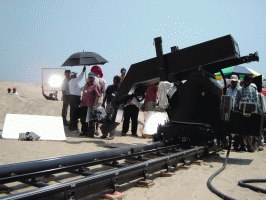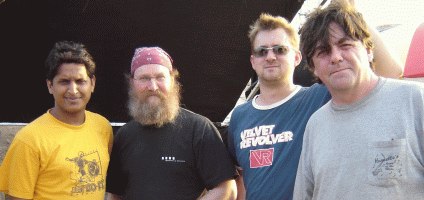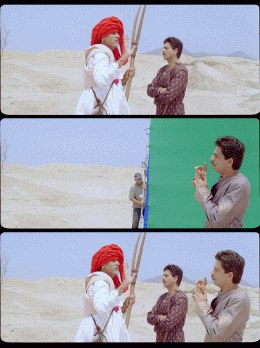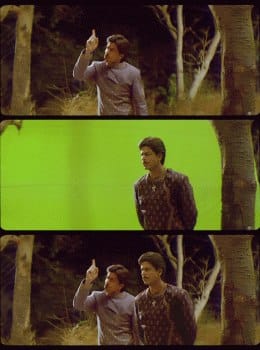Motion Magic for Paheli – Courtesy of Asia Image Magazine
Motion Magic for Paheli – Courtesy of Asia Image Magazine
Paheli, the latest Indian blockbuster by acclaimed director Amol Palekar and producer-actor Shah Rukh Khan, shows how motion control can solve the most difficult of visual effects shots.
Romance, drama, betrayal. The dilemma of lovers, a symphony emotions, an encounter with the supernatural. A mix of magical ingredients create the lassi that is Paheli, the latest Indian blockbuster by acclaimed director Amol Palekar, known for his flair for the comical in films such as Golmaal, Choti Si Baat, Baaton Baaton Main, and Rajnigandha.
Produced by Shah Rukh Khan, whose company Red Chillies Entertainment produced the film, and who is also lead actor, Paheli tells of a husband whose vault in his heart only has room for money, the lovely girl who seems destined to spend her matrimony in solitude when her husband leaves on a five-year business trip on their marriage night, and the love struck ghost who decides to assume the form of her husband in order to be with her. The ghost tells her the truth on their first night together, and she accepts him.
All is well until the husband comes back five years later on news of her pregnancy and is greeted by the sight of his likeness living with his wife and family. That both husband and ghost is played by Shah Rukh Khan does not surprise, but when key scenes such as the moment of revelation at the husband’s return called for both characters to appear side-by-side, Vishal Punjabi, visual effects producer, had to perform some magic of his own. The answer came in the form of a Milo motion control rig from Prime Focus, Mumbai, but not before Punjabi had to contend with skeptical bosses and uncooperative forces of nature.


“When I started my first visual effects breakdown from script to storyboard, I knew we needed the Milo rig to achieve what I wanted, but both director Amol Palekar and Shah Rukh Khan were very skeptical and were under the impression that it would take 16 hours to set up and would not be very reliable,” he revealed. “It took me more than 10 meetings and 62 hours of convincing before I could get them to agree,” recalls Punjabi. The indefatigable Punjabi managed to convince both director and producer that the set up would be much less onerous, and that the Milo was necessary as the film required multiple replications of the same character and also interaction between these characters.
Green light given, motion control operators Damian Davison and Jay Mallet were contacted and swiftly put on the job. “The reason for using the Milo was to enable the star of the film – Shah Rukh Khan – to act and react with himself, so careful planning as to the order of shooting was essential. The camera moves themselves had to be quite straightforward, as any acrobatics would not cut with the rest of the film,” shares Davison. “The priority for me was to see the Milo and check out its condition. Unfortunately the production company had heard some stories about motion control and was very nervous about committing themselves to using it at all,” he continues. “However the Milo was in very good condition, all the various settings, target tracking, and carts were fine, so we plotted a simple three-point camera move – target tracking around a water bottle – in about 10 minutes. This speed in plotting the move convinced the production company that the Milo was what they needed for the shoot. Also I was able to familiarise myself with the new version 4 software,” continues Davison. “The reason for our presence on the Paheli set was not that the Indian crew was incapable of the shots required but there seemed to be concerns about limited time allotted for the motion control,” confirms Mallet. He adds, “We were there to put his mind at rest and also show that moco was a fast and cost effective means of shooting. This was achieved on the first day of filming after we had completed four shots at the end of the first day.”
The Milo ascertained to be of good condition, Davison and crew set out to do a location scout in Rajasthan, which turned out to be off limits. “The only access was by camel and the sand dunes were so soft and unstable I didn’t want to see a Milo sinking into the sand or rolling down the side of a dune. Eventually a much better desert location was built on top of a helipad at Film City, which is Mumbai’s main film studio and also has a back lot the size of Essex,” quips Davison.The creation of a white-hot desert in sweltering Mumbai required over four hundred trucks of sand, loads of wood and fibre, and over 100 men before a helipad was transformed into a realistic desertscape, recalls Punjabi.
“I tried to keep the first schedule as simple as possible just so the crew could get used to shooting with the Milo and it went off smoothly. We had live compositors on shoot who would show the director the shots within minutes of taking and that made him more confident,” says Punjabi. “In order to see the shots together and to check interaction I had requested that a full mix and overlay package should be on set, and that this package should also be able to trigger the rig from a time coded source,” adds Mallet. “This was not able tobe supplied in time so the decision was made to bring a Shake compositing workstation on to the set, so we could create rough comps in order to check the shots after shooting,” he explains.
This move proved to be a winner in gaining the confidence of director Paleka. “Honestly I was a bit skeptical of using the Milo but Shah Rukh left no stone unturned in his production of my film Paheli. Vishal Punjabi, the visual effects producer of the film hunted down some of the finest Milo operators in the world for the shoot and managed to set up a compositing team on location to show me the shots, minutes after taking, which was something I have never seen before.
“When scripting, I always thought of how we would show the two characters together and on our very first visual effects sitting, my problem was solved,” enthuses Paleka. Much of the visual effects magic that happened on the set was enabled by the Milo motion control rig. Built in West Sussex, England, the rig comprises of 11 axis of controllable movement. Management of the Milo can be accessed via any laptop computer running the control programme called Flair, which allows users to store axis points for all axes in the main user screen and also calculate smooth moves between points.

“The Milo can control a selection of cameras but in general the main cameras used are the Mitchell s35, or the Arri 435 Advanced,” says Mallet. “During Paheli, shooting took place on an Arri 435 advanced. We were able to control the functions of the camera for accurate repeat passes. If full control cannot be made, it is still possible to take sync from the camera and synchronise with the Flair software.” The Milo used in Paheli ran on a Mark Roberts Motion Control precision rail. Sitting on top of loaded bearings on the customised rail enables the rig to move at great speed, depending on the style of move desired. Shedding more light on the technical minutiae behind the shoot, Mallet elaborates: “With the Paheli effects moves, a sync light, called a bloop light, was placed in the shot in order to give the compositor the ability to line up the various passes easily. This light is controlled from the rig’s root box that in turn is controlled by the Flair software. This light flashes on the first frame of the move or at whatever frame it is programmed to fire at.”
A technique called target tracking was also utilised on Paheli. This is a technique that allows the operator to programme where the rig looks between key frames, ie, the rig is given a metric value distance at a keyframe and the rig then knows to keep that distance from the object. This function of the rig is particularly useful when trying to create a curved move around a subject. As shooting got underway and comfort levels increased, the performance of the Milo impressed to the extent that extra shots originally planned for a locked off camera were added. By then, all that was left to wrestle with were the forces of the land. As Davison shares, “The only real problems we encountered were heat and an erratic power supply. I had a strong urge to paint the rig white, and at one point the camera body had its own parasol bearer.” “The terrain was rough but manageable. Heat was perhaps our main concern for the rig in this environment. Fans and umbrellas were used to cover the rig when not shooting,” commiserates Mallet. “The shoot was divided into two parts with a gap in shooting of about 10 days. The shoot went without a hitch and was a pleasure to work on. Vishal and the producers were very happy with the results and have invited Damian and myself back to shoot and also adviseon motion control for future ventures,” he adds.


Certainly, the amalgamation of a competent technical crew – and no doubt some kismet – made for a smooth integration of the Milo into the production. Punjabi shares, “Working with professionals like Damian and Jay was brilliant. They adjusted to our style of working, were patient, and most important of all, they knew exactly what they were doing. Shots were set up in 20 minutes flat and time just flew by. “Having Shah Rukh on set with us also made our work much easier. He always hits his mark, his timing was perfect on every single take, and he always maintained his looks with the character. It is very important to have an actor who understands what you are trying to achieve and is patient with the technology you are using. It was a dream come true to work with him on this shoot,” Pujabi effuses.
And what does the producer-lead actor who has the schizophrenic task of playing both husband and ghostthink of the use of the Milo despite initial reservations? “Shooting with the motion control rig here in India was amazing. It is not very often my crew is exposed to this kind of equipment and it was just great to see it work and move. A bit scary at times when this huge black dragon-like machine comes hurtling towards your face and you have to perform in front of it. Yes, it was very intimidating,” confesses Shah Rukh.
“As a filmmaker it was great to have Vishal and his team from Eagle Video Films present on shoot to plot the moves as they would do live composites and match the takes to ensure the director got what he wanted. I think this is the first time I have seen something like this and it was a relief. I guess the end result speaks for itself.”
